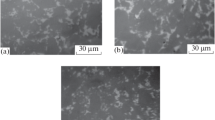Conclusions
The effect of alkalis, slag, and carbon monoxide on silicon carbide and nitride was studied at elevated temperatures up to 1550°C. It was established that silicon carbide is destructed most rapidly at 1200°C under the action of the investigated factors. The properties of silicon nitride virtually do not change on heating up to 1400°C in the presence of carbon monoxide; one observes a slight decrease in the nitrogen content of the system only at 1550°C and an increase in the silicon content in the 1200–1550°C range due to the dissociation of Si3N4 and the formation of Si2ON2.
At 1200 °C, carbon monoxide and alkalis significantly influence the property variation of the silicon carbide refractories containing a silicon nitride-based binder only during the first 2 h of holding; this is confirmed by the abrupt decrease of the open porosity and the apparent density during this period. Further increase in the holding period up to 16 h does not have a significant effect on the variation of the properties of the products owing to the protective glassy coating formed on the refractory surface as a result of partial oxidation of SiC. Our studies confirmed that the silicon carbide refractories containing a silicon nitride binder possess a high degree of stability under aggressive conditions.
Similar content being viewed by others
Literature cited
I. G. Ochagova, Ogneupory, No. 5, 49–52 (1984).
K. Hiragushi, K. Mizutani, and T. Nagai, Iron Steel Eng., No. 6, 47–53 (1978).
Fachber. Hüttenprax. Metallweiterverarb.,14, No. 7, 804 (1976).
N. V. Pitak, T. P. Khmelenko, R. M. Fedoruk, et al., Ogneupory, No. 10, 29–33 (1984).
N. V. Pitak, R. M. Fedoruk, and T. P. Khmelenko, Metallurg. Gornorud. Promysh., No. 2, 47–49 (1985).
N. V. Pitak and B. N. Starshinov, Ogneupory, No. 5, 1–8 (1982).
G. G. Gnesin, Silicon Carbide Materials [in Russian], Metallurgiya, Moscow (1977).
A. I. Kulikov, Izv. Akad. Nauk SSSR, Neorg. Mater.,20, No. 1, 111–114 (1984).
Yamaguchi Akira, Taikabutsu (Refractories),35, No. 310, 617–622 (1983).
R. N. Andrievskii and I. I. Spivak, Silicon Nitride and the Materials Based on It [in Russian], Metallurgiya, Moscow (1984).
Author information
Authors and Affiliations
Additional information
Translated from Ogneupory, No. 2, pp. 1–4, February, 1988.
Rights and permissions
About this article
Cite this article
Pitak, N.V., Fedoruk, R.M., Khmelenko, T.P. et al. Resistance of silicon carbide refractories to the action of carbon monoxide, alkalis, and slag. Refractories 29, 69–73 (1988). https://doi.org/10.1007/BF01386609
Issue Date:
DOI: https://doi.org/10.1007/BF01386609




